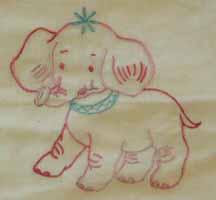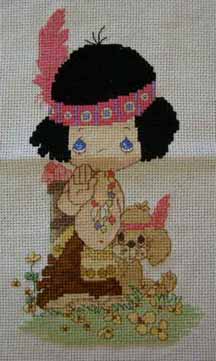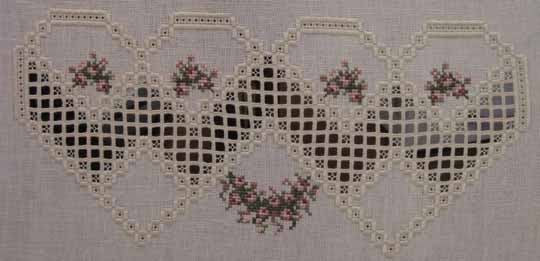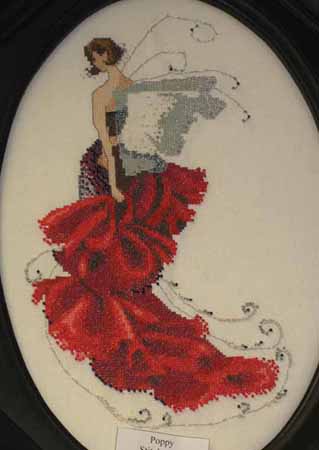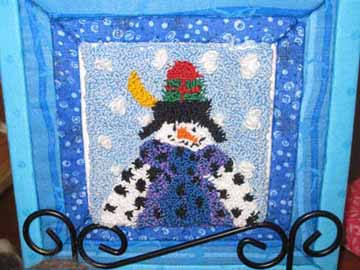|
Hand EmbroideryMy Little Hand Embroidery Embroidery has been around for thousands of years. In one needlework form or another, it has been used by just about every culture on earth. It’s been used to decorate homes with beautiful accessories like bedding, curtains, table cloths, pillows, etc....and to decorate clothing. It was used on clothing, both for decoration, and to display status. The more intricate and amount of design, the higher the status of the person wearing it. Ceremonial robes and special occasion clothing throughout history have been covered with intricate bead and needle work. Now days, hand embroidery is used mostly just for decoration or embellishment. Embroidery was an art taught to many young ladies throughout the world’s history. Different forms and techniques come to us from all over the world. With all of the wonders this world has to offer us, (like the internet) we are fortunate enough, to be able to learn many of those different styles and techniques. Women and men both are discovering how enjoyable and relaxing needlework can be. The beauty and knowledge of these techniques does not have to be lost to time. We can preserve them and give them new life. Possibly even pass them on to our children. And our children’s, children. (Sorry if I seem to be a little dramatic and sentimental. I tend to get that way when talking about history....much to the annoyance of my children and husband!! Probably most of my friends, too, now that I think about it!) ♥♥♥♥♥♥♥♥♥ ;♥♥♥♥♥♥♥♥♥♥♥♥b 29;♥♥♥♥♥♥♥
Above design stitched by Faye Johansen This term encompasses a large many styles and techniques of needlework. Almost all types of needlework fall into the category of hand embroidery. Most have their own name, but still get referred to simply as embroidery. Basic hand embroidery is made up of many different stitches done in different ways to create different effects. It can be done on any type of fabric. Even weave fabrics are used when making samplers or some other project that requires stitches to be uniform. Multiple stranded embroidery floss is used to obtain different effects. More strands for thicker stitches, and less strands for thin, daintier stitches. Thick thread can also be used.
This kind of embroidery is mostly used to decorate household items and clothing. Samplers of different stitch methods are the most popular use of basic hand embroidery, today. Some quilters also use this type of embroidery to add to their quilt designs. By outlining certain parts of a fabric pattern, you get a raised, puffy, effect. This also helps secure the quilt layers together more firmly. When I was growing up, iron on transfers were the popular way to use hand embroidery. You would get a design, iron it onto a table cloth, pillowcase, hand towel or other fabric, and then embroider over the top of it. I did a little of that when I was younger, but I didn’t like the “color within the lines” feel it had. I prefer other methods that use even weave fabrics and do not show how uneven my stitches really are! Click here to see what you need to get started Click here to learn some basic embroidery stitches Below are some of my favorite types of hand embroidery styles. These are in no way, the only styles and techniques out there!! These are just my favorites, and ones I have worked with personally. (I can’t tell you about a style or technique I’ve never used or don’t know much about!!)
Cross stitch is my absolute favorite form of embroidery. It basically is what its name implies: crossed stitches. It’s a design made up of a bunch little “X”s. This is the form I use most. I love to cross stitch! There are three different kinds of cross stitch: Counted Cross Stitch, Stamped Cross Stitch and Embellished Cross Stitch. All cross stitch is done on either Aida Cloth, Linen, or other even weave fabric. You can even purchase cross stitch kits with all the materials included. Click here to learn some cross stitch stitches Blackwork-Whitework-Redwork-Bluework Embroidery This form of hand embroidery is named more for the colors used, rather than a stitch style. They are usually line designs in one single color. All of the design is done in one color: Black, White, Red or Blue. All forms are usually done on white fabric for a bold and striking appearance. Any type of fabric can be used, and any type of straight stitch. Although, straight stitch embroidery is not the only style used with color work, it is the traditional stitch. Any type of embroidery stitches may be used, as long as the color stays uniform. Blackwork and Whitework are the oldest forms of this embroidery. Bluework and redwork seem to be the most popular today. (This style also applies to machine embroidery work.) Candlewicking Candlewicking is a form of Whitework. It is a very simple, yet striking type of hand embroidery. It is made up of knots and short, line stitches (usually a satin or stem stitch). It uses a knot similar to the French Knot of traditional embroidery, called the Colonial Knot. (This knot is sometimes also called a figure 8 knot because of it’s knotting process.) Candlewicking can be done on any type of fabric, but specific candlewick fabric is available in some craft stores. A single ply fine yarn or fine crochet cotton thread is used. Multiple ply threads tend to look messy when used with Candlewicking. (Special candlewicking thread can also be purchased at some craft stores.) Hardanger
Above design stitched by Donnett Hartvigsen Hardanger is another form of Whitework embroidery. This technique uses blocks of satin stitches. (Usually 5 satin stitches over a 4 X 4 area) Certain internal threads are cut to reveal open holes in between the stitches. Most hardanger designs are of geometric or standard shapes. The design comes in when you decide which areas to cut, and which areas to leave fabric. Hardanger usually uses white thread on a white even weave fabric. Beaded Embroidery
Above design stitched by Donnett Hartvigsen Beaded Embroidery is more of an embellished embroidery. You can add beads or other embellishments to any type of hand embroidery. You could even use beads to embellish your machine embroidery. This is just the process of adding beads, either to make up a portion of your project, or just add detail to it. Charms could also be used in place of beads in your embellishment. If it is small and has a hole in it, you can use it for an embellishment! Punch Needle
Above design stitched by Donnett Hartvigsen Punch Needle Embroidery is a little different. It actually uses a special hollow “needle” filled with embroidery floss, fine yarns, threads or ribbon, to complete a design. You actually “punch” the needle through the fabric and when you pull the needle back out, it leaves a small portion of fiber behind. As you continue punching and removing the needle, it creates loops in your fiber on both the back and the front of your work. This style of hand embroidery can be done on any fabric. Since you punch the needle through the fabric to create your design, an even weave is not necessary. As I said before, there are so many different types of hand embroidery out there. These are just a few of the ones I have personal experience with, and love. Do some research. Try out some different styles. I’m sure you can find a method to fall in love with, too! Go to Hand Embroidery Supplies ♥♥♥♥♥♥♥♥♥♥♥♥♥♥♥♥♥♥♥♥♥♥♥♥♥♥♥♥♥♥ Want to ♥♥♥♥♥♥♥♥♥♥♥♥♥♥♥♥♥♥♥♥♥♥♥♥♥♥♥♥♥♥ Return to Embroidered Gifts
|





